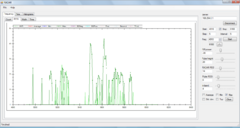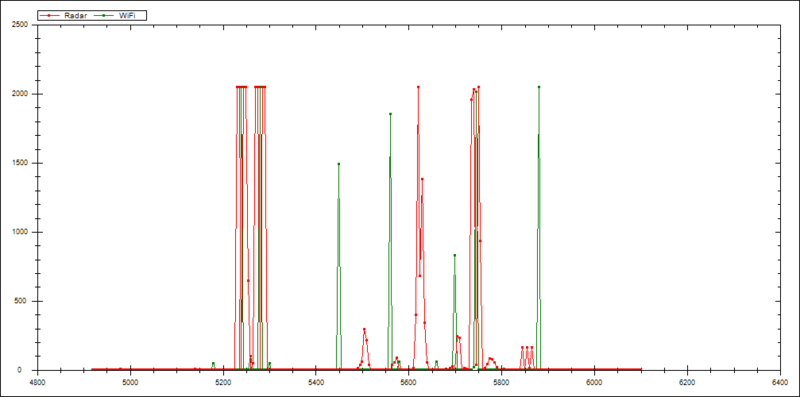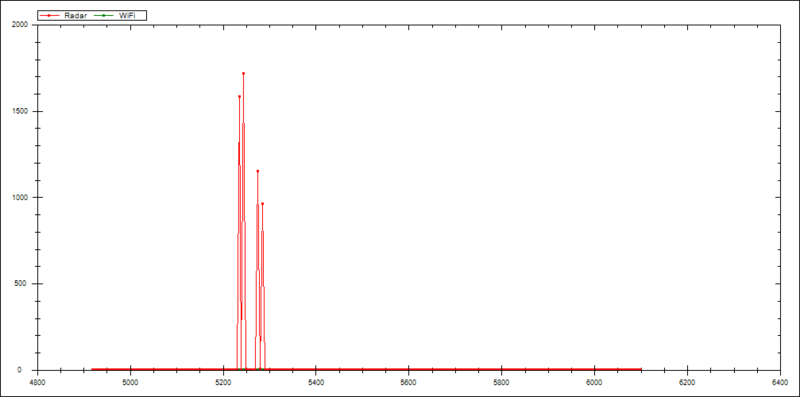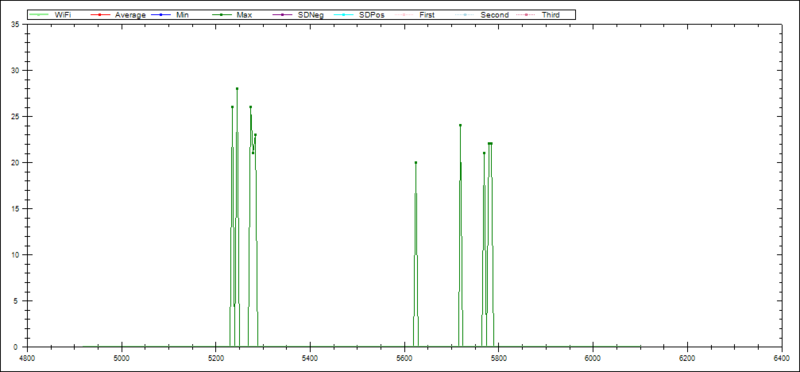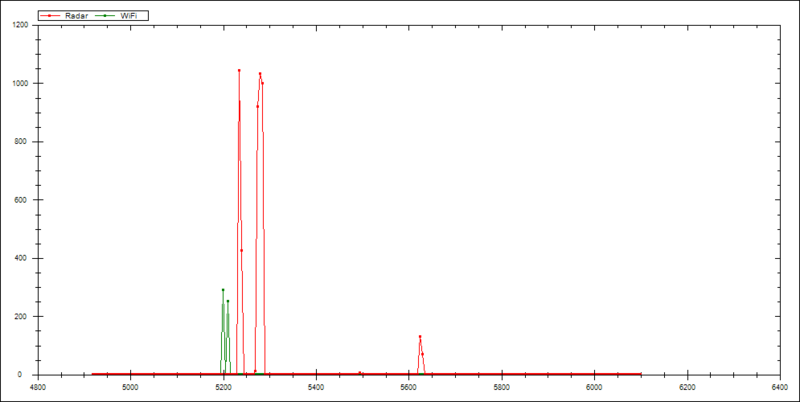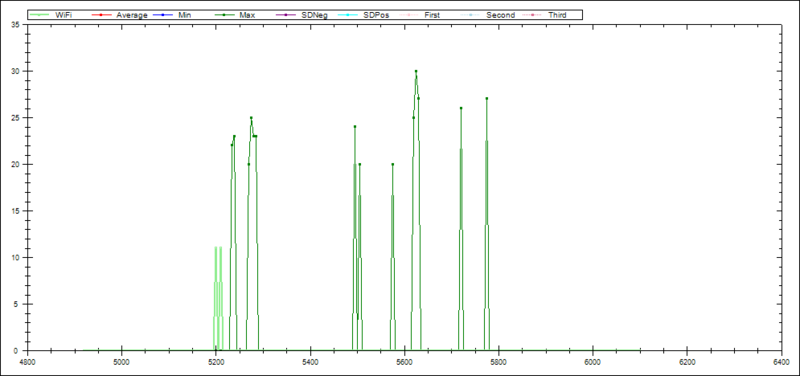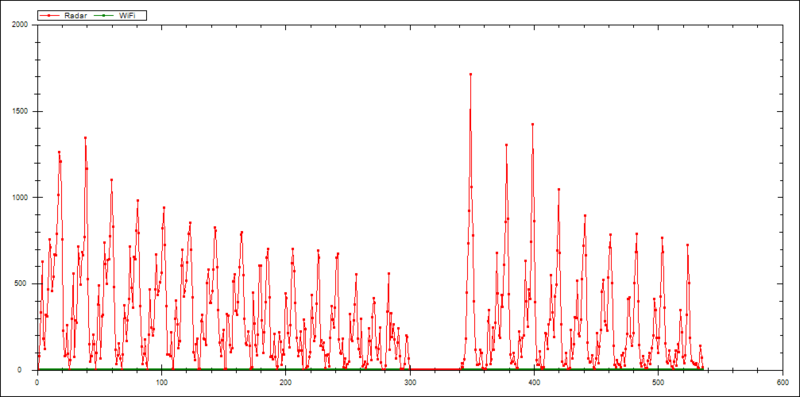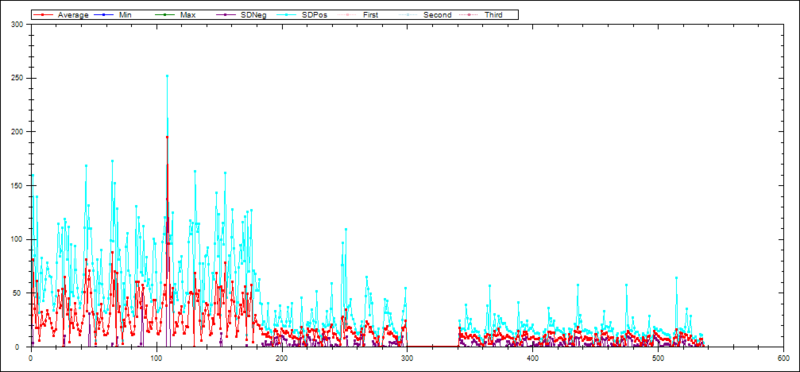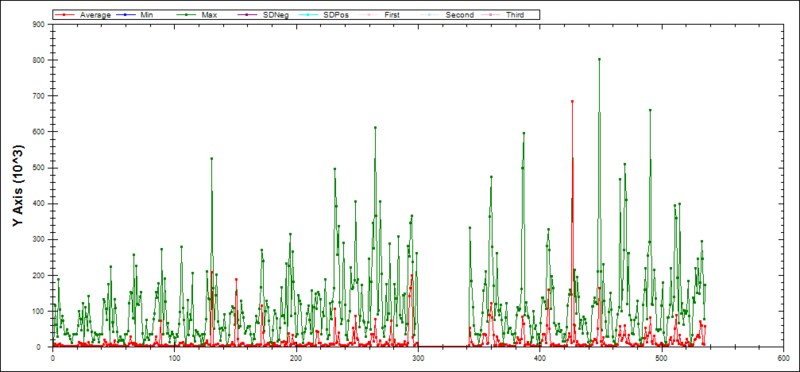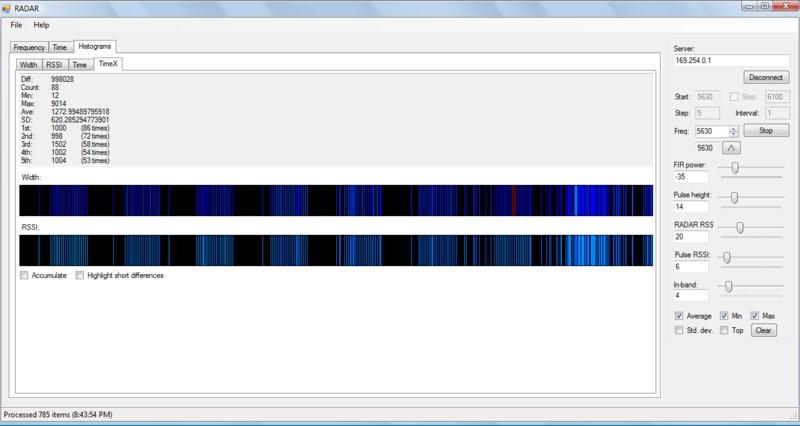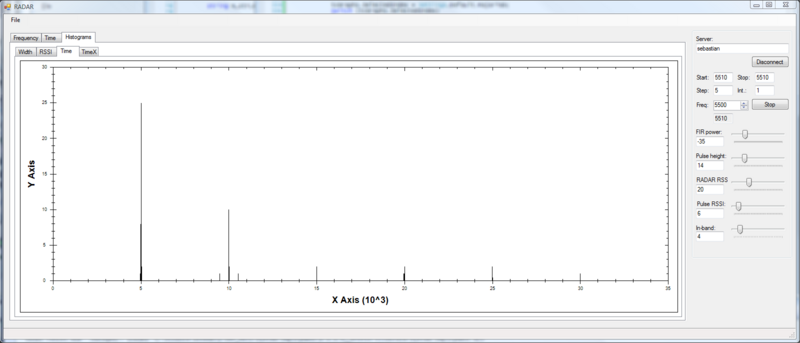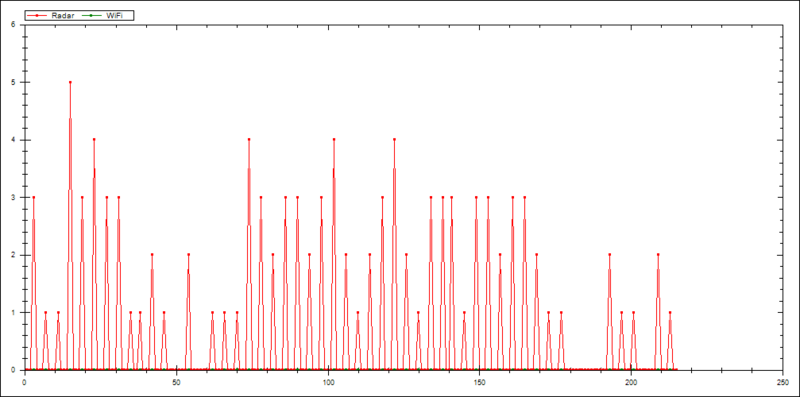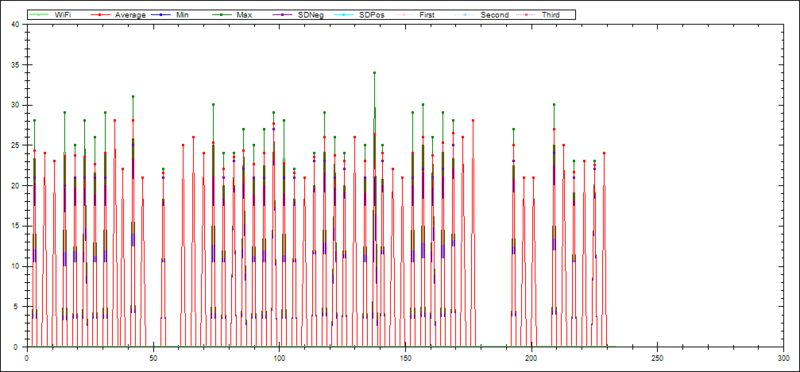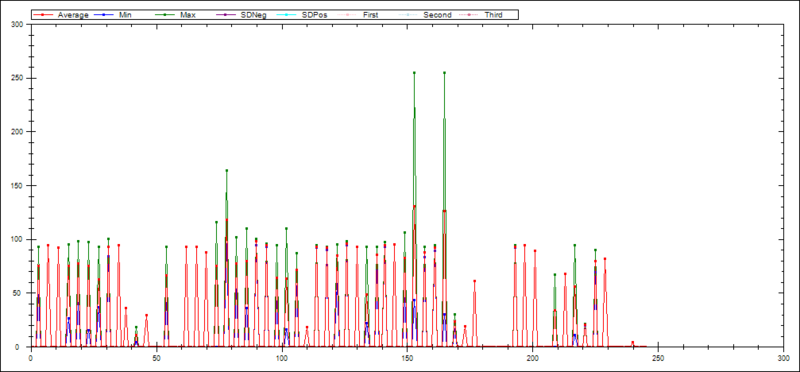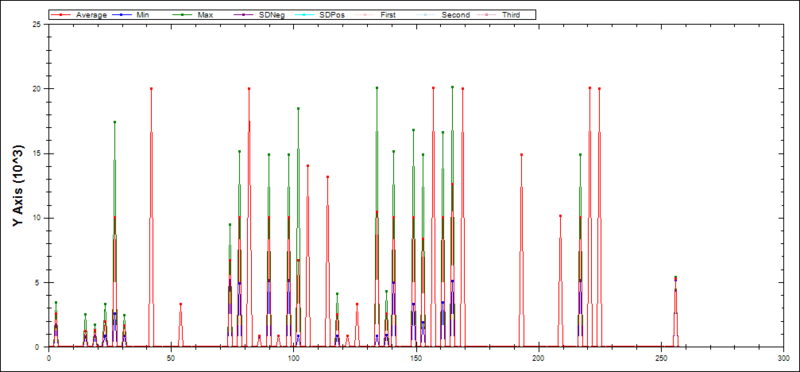Difference between revisions of "RADAR"
(→DFS with ath5k: Files) |
(→Server: Protocol) |
||
| Line 87: | Line 87: | ||
Operates by default on port 5256. | Operates by default on port 5256. | ||
| + | |||
| + | All frequencies are in MHz (e.g. 5500). Sweep range can go backwards. | ||
| + | |||
| + | Simple plain-text line-based protocol: | ||
| + | |||
| + | FREQ <freq> | ||
| + | |||
| + | Thresholds (as in driver, see patch for details): | ||
| + | |||
| + | FIRPWR <pwr> | ||
| + | RSSI <rssi> | ||
| + | PHEIGHT <height> | ||
| + | PRSSI <rssi> | ||
| + | INBAND <threshold> | ||
| + | |||
| + | |||
| + | |||
| + | START [start freq: 4920:] [end freq: 6100] [freq step: 5] [sampling interval in seconds, can be floating point: 1] | ||
| + | STOP | ||
| + | |||
| + | To continually scan one frequency, use same start and end frequency. | ||
| + | |||
| + | To terminate (will stop active sweep): | ||
| + | |||
| + | QUIT or EXIT | ||
| + | |||
| + | or just disconnect. | ||
| + | |||
| + | Details are sent back as: | ||
| + | |||
| + | DATA <freq> <Base64 encoded list of RADAR error structs> | ||
===== Stand-alone console ===== | ===== Stand-alone console ===== | ||
Revision as of 12:03, 26 January 2012
Contents
[hide]DFS with ath5k
- With a view to Dynamic Frequency Selection powered by RADAR PHY errors reported to the driver.
Visualisation of RADAR activity
- Patched ath5k driver reports PHY error details to userspace via debugfs.
- Python daemon on Linux collects details, sweeps frequency ranges on-demand, and reports details to any connected client over the network.
- .NET GUI visualises legitimate WiFi packets and RADAR errors over frequency/time, plots histograms of pulse width, RSSI distribution, time between pulses, and draws time-series graphic to help uncover repetition rate within a sample of pulses.
Files
ath5k Linux kernel driver patch
This is a diff against compat-wireless-2011-10-11. I had to apply some additional patches/fixes to enable it to compile against my existing kernel (2.6.26 x86):
- 022-atomic64_backport.patch is in the root directory in case you need it too (but is not applied by my driver patch).
My config.mk:
diff compat-wireless-2011-10-11.orig/config.mk compat-wireless-2011-10-11/config.mk
224c224
< # CONFIG_ATH5K_DEBUG=y
---
> CONFIG_ATH5K_DEBUG=y
615c615
< # CONFIG_ATH_DEBUG=y
---
> CONFIG_ATH_DEBUG=y
NOTE: Debug mode is necessary for the information to be passed to userland via debugfs!
Also add to fstab:
none /sys/kernel/debug debugfs
And make sure debugfs is enabled in your kernel!
Python
Two types:
- TCP server for GUI
- Stand-alone for console
They have plenty of command-line arguments, so remember to check them with '-h'.
Both scripts rely on knowning how to decode the RADAR error struct passed down from the kernel. If this is different for you from the default, make sure you update these scripts!
The RADAR queue length must match the driver's one (2048 by default, can be change as command-line argument).
And
struct ath5k_radar_error {
u32 tsf;
u8 rssi;
u8 width;
u8 type;
u8 subtype;
};
must match:
sizeof_radar_error = 4+1+1+1+1
and
item = struct.unpack("Icccc"...
(and also the way it is used by the radar_error class).
Server
Operates by default on port 5256.
All frequencies are in MHz (e.g. 5500). Sweep range can go backwards.
Simple plain-text line-based protocol:
FREQ <freq>
Thresholds (as in driver, see patch for details):
FIRPWR <pwr> RSSI <rssi> PHEIGHT <height> PRSSI <rssi> INBAND <threshold>
START [start freq: 4920:] [end freq: 6100] [freq step: 5] [sampling interval in seconds, can be floating point: 1] STOP
To continually scan one frequency, use same start and end frequency.
To terminate (will stop active sweep):
QUIT or EXIT
or just disconnect.
Details are sent back as:
DATA <freq> <Base64 encoded list of RADAR error structs>
Stand-alone console
Output
Monitoring RADAR detection in the console
Type:
watch -n 1 "cat /sys/kernel/debug/ieee80211/phy0/ath5k/radar"
to get:
Every 1.0s: cat /sys/kernel/debug/ieee80211/phy0/ath/radar RADAR detection enabled: 1 RADAR PHY error filter: 0 Filter output power threshold: 44 (44) Pulse height threshold: 28 RADAR RSSI threshold: 15 Pulse RSSI threshold: 58 In-band threshold: 9 RADAR error queue usage: 0/2048 (start: 0, overflows: 0) RADAR errors: 0 PHY errors: 0 Other errors: 0 Frames: 0 Width: 0: 0 1-50: 0 51-100: 0 101-150: 0 151-200: 0 201-250: 0 251-254: 0 255: 0
Manually setting RADAR detection parameters
For example (adjust depending on your interface index):
echo "firpwr -60" > /sys/kernel/debug/ieee80211/phy0/ath5k/radar echo "rssi 1" > /sys/kernel/debug/ieee80211/phy0/ath5k/radar echo "pheight 1" > /sys/kernel/debug/ieee80211/phy0/ath5k/radar echo "prssi 1" > /sys/kernel/debug/ieee80211/phy0/ath5k/radar echo "inband 31" > /sys/kernel/debug/ieee80211/phy0/ath5k/radar
Spectrum Sweep
20MHz channel width
- Notice how RADAR errors are reported either side of a legitimate WiFi channel:
10MHz channel width
- No WiFi operating at this channel width:
5MHz channel width
- Some WiFi operating at this narrow channel width:
Kurnell Weather RADAR
- Registered as a Bureau of Meteorology Weather RADAR: http://www-cluster.bom.gov.au/inside/oeb/radar/sydney.shtml
- Registered on RFMap:
- 5.625 GHz (1.1 MHz bandwidth at 250 kW)
- Following data was received on ~5500/~5600 MHz
- One can infer the rotation rate of the RADAR by examining the difference in time, especially in the 'Counts' (number of reported RADAR PHY errors) over time:
- Average RSSI decreases a little in each 'transmission section' (separated by the pause in-between), however decrease is most noticable in the maximum value per sample-group:
- Not sure why the distribution of widths changes later (was this when my laptop was knocked off its perch by the wind?!):
- Whatever the change above, it is also reflected here:
- 1kHz PRF
- You can see that the five highest bins (which hold counts for the distinct times between detected RADAR pulses) have values of ~1000. The time-series plot shows the regular repetition:
- 5kHz PRF
- As above, however this time it's ~5000:
- This is also reflected in the time-between-pulses histogram:
ISM
- Indoors, the sweep looks quite different:
- Notice the significant response at 5800MHz. Could this be DECT nearby?
- Examing the time-series plot of RSSI for 5800MHz clearly shows a regular, repeating group of pulses (not as apparent due to the colouring on the width plot as the pulse widths seem to be changing moreso, however the time-between pulses is identical):
5140MHz
- No idea what this is, however it appears rather regular (also note the regular pauses between groups of RADAR errors):
| ||||||||||||||||||||||||||||||||||||||||||||||||||||||||||||||||
